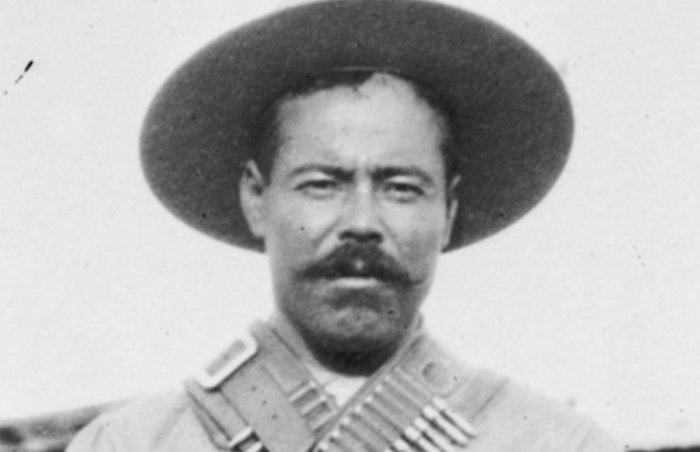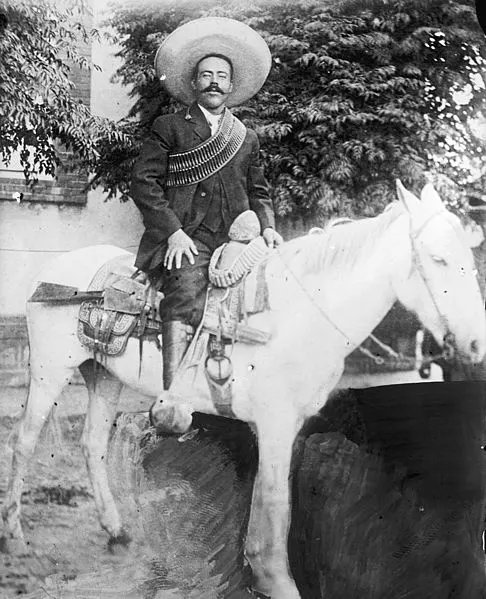Pancho Villa – Mexico’s Robin Hood – A Ruthless Bandit Or A Hero?
Ellen Lloyd - AncientPages.com - Some admired and called him a hero, but some said he was a brutal bandit and cold-blooded murderer. His charisma, extraordinary leadership skills, and courage gave him legendary status, and there is no doubt he made an impression on those he met.
Nevertheless, certain parts of his life are still shrouded in mystery, and Pancho Villa's story fascinates the modern world.
Pancho Villa (1878 - 1923). Credit: Public Domain
No one really knows how everything started, and there is conflicting information about Pacho Villa's early life. Still, it seems sad and tragic events forced Pancho Villa to take matters into his own hands and fight for justice. Like everyone, Pancho Villa had a choice, so he sought revenge on those who had caused him pain in his early life.
Who Was Pancho Villa?
Born on 5 June 1878 and named José Doroteo Arango Arámbula at birth, Pancho Villa became a bandit at a young age. He grew up at the Rancho de la Coyotada in Durango, northwest Mexico. As a young boy, he had not much time for education. After his father's death, Panchi Villa had to quit his studies at the local church-run school and help his mother.
When Pancho Villa was only sixteen, he shot Agustín Lopez Negrete, a hacienda owner who had raped his sister. Later, he stole a horse and fled to Durango's Sierra Madre Occidental region, where he roamed the hills as a thief.
It was the beginning of his criminal history. He spent nine years in the mountains, joining a band of outlaws led by the famous bandit leader Ignacio Parra. At that time, Villa was known under the name "Arango."
On one occasion, in 1902, he was arrested for stealing mules and assault. He was spared a death sentence because he had good connections with influential people.
How Pancho Villa Became A Mexican Robin Hood
After deserting the Federal Army, he fled to the neighboring state of Chihuahua. During this period, Pancho became known as Mexico's Robin Hood.
Pancho Villa. Credit: Public Domain
He stole from the rich and gave to the poor so they could feed their families. Poor laborers loved Pancho. He was a criminal but helped those in need, and these deeds made him a hero. One can say that Pancho reminds us in some ways of Bulla Felix, a legendary Italian leader of outlaws who robbed the rich and gave to the poor.
However, Pancho Villa was undoubtedly a dangerous man who showed no mercy to traitors. If people refused to pay his gang, he could murder the person horribly and painfully. He earned his reputation as one of Mexico's best gunfighters, nicknamed "El Centauro del Norte" (The Centaur of the North). His temper and fury were well-known, but his soldiers respected him.
"In 1914, Villa refused to be elected president of Mexico, a title that ended in the hands of Carranza, who rapidly began to impose his new dictatorship, promptly using his power over the press to depict Pancho Villa as a monstrous and brutal bandit leader to alienate him from the people's favor." (American Myths, Legends, and Tall Tales: An Encyclopedia of American Folklore)
During the Mexican Revolution, Villa's military campaigns and rebel forces were praised by supporters, but in 1915 his men suffered a massive defeat at the Battle of Celaya. By the end of 1915, Villa was on the run, and the United States government recognized Carranza.
Pancho Villa had no choice but to cross the border and hide in the mountains. Only a few men were loyal to him, and President Wilson sent 5,000 men to hunt Villa down.
In 1920, Carranza was assassinated, and Villa was offered amnesty and a large estate in exchange for his retirement. Villa accepted the offer but was killed three years later in Parral, Mexico.
Equestrian bronze of Villa in Chihuahua, Chihuahua. Image credit: Lyricmac - CC BY-SA 3.0
The "circumstances surrounding his death are still unclear and filled with legendary elements such as the following bizarre events, including the exhumation and decapitation of his body. Local rumors say that an American treasure hunter beheaded him to sell his skull to an eccentric millionaire who collected the heads of historical figures," Claudio Butticè writes in American Myths, Legends, and Tall Tales, An Encyclopedia of American Folklore.
Pancho Villa Became A Legend And Is Still Remembered
Villa legends pervade not only Mexico but the United States as well and have even reached beyond. They exist not only in the popular mind, in popular tradition, and in popular ballads but also in movies made in Mexico and Hollywood.
As Friedrich Katz writes in the book, The Life and Times of Pancho Villa, "alongside Moctezuma and Benito Juárez, Pancho Villa is probably the best-known Mexican personality worldwide.
'There are legends of Villa the Robin Hood, Villa the Napoleon of Mexico, Villa the ruthless killer, Villa the womanizer, and Villa as the only foreigner who has attacked the mainland of the United States since the war of 1812. Whether correct or incorrect, exaggerated or true to life, these legends have resulted in Pancho Villa, the leader obscuring his movement, and the myths covering the leader.
So much attention has focused on Villa himself that the characteristics of his movement, in many respects, make it unique in Latin America and, in some ways, among twentieth-century revolutions, have either been forgotten or neglected. Villa's Division del Norte was probably the largest revolutionary army that Latin America ever produced. The revolution he led was the only social revolution ever to occur along the border of the United States. It was also one of the few genuine revolutions produced by what might best be described as a frontier region on the American continent.'
Written by Ellen Lloyd – AncientPages.com
Updated on January 2, 2024
Copyright © AncientPages.com All rights reserved. This material may not be published, broadcast, rewritten or redistributed in whole or part without the express written permission of AncientPages.com
Expand for referencesMore From Ancient Pages
-
 Mysteries Of The Huldufolk – The Hidden People Of Iceland
Featured Stories | Feb 1, 2022
Mysteries Of The Huldufolk – The Hidden People Of Iceland
Featured Stories | Feb 1, 2022 -
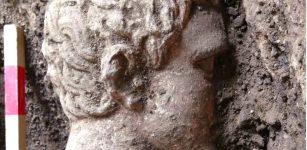 Incredibly Well-Preserved 2,000-Year-Old Statue Of Greek God Hermes Found In Heraclea Sintica, Bulgaria
Archaeology | Jul 12, 2024
Incredibly Well-Preserved 2,000-Year-Old Statue Of Greek God Hermes Found In Heraclea Sintica, Bulgaria
Archaeology | Jul 12, 2024 -
 Did First Settlers From Asia Reached America By ‘Stepping Stone’ Migration Across Bering Sea?
Archaeology | Apr 30, 2021
Did First Settlers From Asia Reached America By ‘Stepping Stone’ Migration Across Bering Sea?
Archaeology | Apr 30, 2021 -
 Ancient Byblos: Powerful Phoenician City With Own Kings
Civilizations | Apr 23, 2016
Ancient Byblos: Powerful Phoenician City With Own Kings
Civilizations | Apr 23, 2016 -
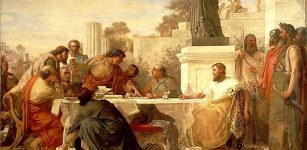 On This Day In History: Julian ‘The Apostate’ Died During The Retreat From The Sassanian Empire – On June 26, 363
News | Jun 26, 2016
On This Day In History: Julian ‘The Apostate’ Died During The Retreat From The Sassanian Empire – On June 26, 363
News | Jun 26, 2016 -
 200 Tons Of Silver Hidden From The Romans On The Shores Of The River Lahn
Archaeology | Feb 23, 2023
200 Tons Of Silver Hidden From The Romans On The Shores Of The River Lahn
Archaeology | Feb 23, 2023 -
 Astrolabe: A Beautiful, Mysterious And Sophisticated Computer Of The Ancient World
Ancient Technology | Jul 2, 2016
Astrolabe: A Beautiful, Mysterious And Sophisticated Computer Of The Ancient World
Ancient Technology | Jul 2, 2016 -
 In Ancient California Matriarchal Society, Daughters Breastfed Longer And Women Accumulated Greater Wealth
Archaeology | Jul 13, 2023
In Ancient California Matriarchal Society, Daughters Breastfed Longer And Women Accumulated Greater Wealth
Archaeology | Jul 13, 2023 -
 Hippocrates Didn’t Write The Oath, So Why Is He The Father Of Medicine?
Featured Stories | Oct 7, 2015
Hippocrates Didn’t Write The Oath, So Why Is He The Father Of Medicine?
Featured Stories | Oct 7, 2015 -
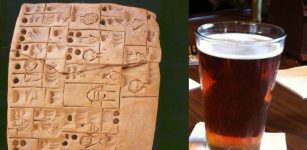 Oldest Evidence Of Beer Was Found On A Sumerian Tablet In Mesopotamia
Ancient History Facts | Jan 23, 2016
Oldest Evidence Of Beer Was Found On A Sumerian Tablet In Mesopotamia
Ancient History Facts | Jan 23, 2016 -
 Why Was The Urnes Brooch So Popular At The End Of The Viking Age?
Archaeology | May 27, 2023
Why Was The Urnes Brooch So Popular At The End Of The Viking Age?
Archaeology | May 27, 2023 -
 Unknown Holographic Technology Hidden In Old Monastery Reveals A Surprising Secret
Featured Stories | Dec 7, 2018
Unknown Holographic Technology Hidden In Old Monastery Reveals A Surprising Secret
Featured Stories | Dec 7, 2018 -
 Underground Man-Made Longyou Grottoes Remain An Ancient Unsolved Mystery
Ancient Technology | Jan 16, 2019
Underground Man-Made Longyou Grottoes Remain An Ancient Unsolved Mystery
Ancient Technology | Jan 16, 2019 -
 1,000-Year-Old Bone Skate Found In Moravian City Of Přerov, Czech Republic
Archaeology | Mar 20, 2024
1,000-Year-Old Bone Skate Found In Moravian City Of Přerov, Czech Republic
Archaeology | Mar 20, 2024 -
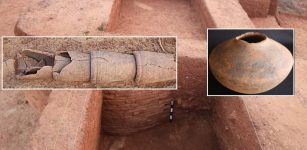 2,000-Year-Old Trade Center: Brick Structure, A Vishnu Sculpture Among Findings In Andhra Pradesh
Archaeology | Nov 6, 2019
2,000-Year-Old Trade Center: Brick Structure, A Vishnu Sculpture Among Findings In Andhra Pradesh
Archaeology | Nov 6, 2019 -
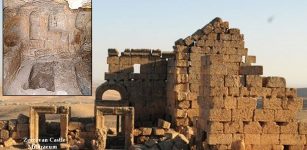 New Discoveries In Excavated Ancient Temple Linked To Secret Mithras Religion
Archaeology | May 15, 2018
New Discoveries In Excavated Ancient Temple Linked To Secret Mithras Religion
Archaeology | May 15, 2018 -
 Ancient Statue Of Makara, Legendary Sea-Creature Found In Cambodia
Archaeology | Jan 29, 2020
Ancient Statue Of Makara, Legendary Sea-Creature Found In Cambodia
Archaeology | Jan 29, 2020 -
 Napoleonic Code: Why Was One Of The Most Influential Civil Codes Flawed?
Ancient History Facts | May 16, 2020
Napoleonic Code: Why Was One Of The Most Influential Civil Codes Flawed?
Ancient History Facts | May 16, 2020 -
 Trung Sisters Of Vietnam: National Heroines That Stood Against Cruel Chinese Occupation Of Their Country
Featured Stories | Apr 29, 2019
Trung Sisters Of Vietnam: National Heroines That Stood Against Cruel Chinese Occupation Of Their Country
Featured Stories | Apr 29, 2019 -
 Controversial Discovery Of 5,7-Million-Year-Old Footprints On Crete Could Re-Write History Of Human Evolution
Archaeology | Sep 5, 2017
Controversial Discovery Of 5,7-Million-Year-Old Footprints On Crete Could Re-Write History Of Human Evolution
Archaeology | Sep 5, 2017

